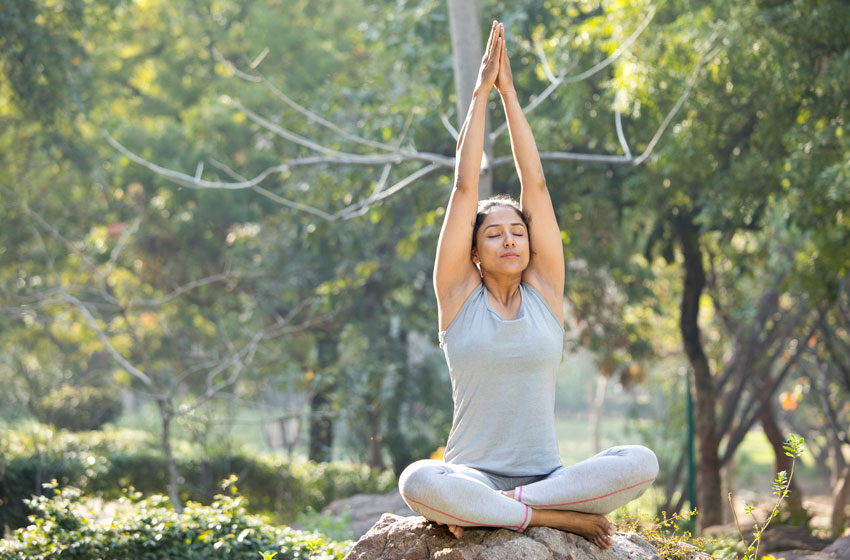Yoga is not just about holding postures and stretching

Yoga’s origin can be traced back to 5,000 years ago in the sacred texts of Rig Veda( an ancient Indian collection of Vedic Sanskrit hymns); over the centuries, it continued to grow and spread across the Indian subcontinent. Therefore, people welcomed their spiritual guidance when Indian spiritual leaders travelled abroad and propounded yoga theories and the intrinsic connection between physical and mental health.
However, how many of us can honestly say that we succeed in maintaining well-balanced physical and mental health? Especially when we are so engrossed in our daily lives trying to accomplish different things professionally and personally. For example, we always rush to get things done before the deadline or ensure that we don’t disappoint that friend or partner.
The word Yoga comes from the Sanskrit word “Yuj”, which means to unite, indicating the union of individual consciousness with that of the universal consciousness. Also, it signifies the perfect harmony between mind, body and soul.
Types of Yoga
There are eight different kinds of yoga, namely :
- Hatha Yoga
- Vinyasa Yoga
- Ashtanga Yoga
- Iyengar Yoga
- Yin Yoga
- Restorative Yoga
- Kundalini Yoga
- Power Yoga
Hatha Yoga is one of the most commonly practiced and popular yoga styles, wherein “ha’ means sun and “tha” means moon. Furthermore, it is not an exercise; instead, we can consider the activities, including postures that help align your body and mind for meditation.
Also, hatha yoga focuses on the “pranayamas” (breath-controlled exercises), and they are followed by a series of asanas(yoga postures) which ends with savasana(the final resting pose at the end of almost every yoga practice). Besides, while practicing yoga, the goal is to challenge yourself physically but at the same time not overwhelm yourselves. Therefore, you should be concentrating on your breath while trying to calm yourself, thereby creating a calm atmosphere.
What are the main benefits of yoga?
It is a stress buster.
Yoga has many stress-reducing techniques, including exercises and learning to control the breath, clearing the mind, and relaxing the body. For instance, breath work or Pranayama is an integral part of any yoga practice; it increases one’s awareness of the breath as a relaxing tool of the body.

When we find ourselves amidst a chaotic situation, we sometimes become agitated and confused because we can’t figure out what to do. Also, people find themselves panicking about such scenarios; hence, they either have a breakdown or do something they regret later. However, if we regulate our breathing by taking deep breaths, it can help us to combat stressful situations.
On the other hand, our mind is constantly active, enabling us to think one thought after the other. Furthermore, we often keep ruminating about the past or spinning about possible future scenarios; hence, it can get quite stressful and frustrating. But yoga provides several techniques that help calm the mind; when we concentrate on our breathing, it helps focus on the present and clears the mind.
Improves better mental health
Yoga helps to produce serotonin naturally, sometimes referred to as” the happy chemicals” because it contributes to feelings of well-being and happiness. Consequently, that helps to stabilise our mood and ultimately elevates us from feeling always down and stressed. Hence, regular yoga practice helps relieve depression and negative emotions with the help of mindful breathing and self-awareness.
One of the most common mental health disorders is MDD(mental health disorder), affecting people of all ages across the world. However, in 2017, a meta-analysis was conducted, wherein 23 interventions were carried out using yoga-based treatments for the depressive symptoms. Consequently, yoga proved to be an effective alternative treatment for MDD.
On the other hand, people who have been struggling to focus on their work benefit from yoga as it helps them clear their minds and strengthen the mind-body connection. Also, yoga tests people’s mental endurance and physical stamina by holding postures and mental endurance. So, apart from improving mental health, it helps to modulate stress response, reduce elevated heart rate, lower blood pressure and eases respiration.
Reduces inflammation

Inflammation is a natural process wherein the immune system reacts or responds to injury, infection, stress, etc. Although inflammation is a good thing, it is a part of the biological system when our bodies combat minor problems. However, prolonged inflammation is unhealthy, especially when it becomes chronic and causes serious health implications. Chronic inflammation can lead to chronic diseases and cause visible signs of ageing. Therefore, apart from maintaining a well-balanced diet and reducing stress, one should include yoga to protect themselves against chronic inflammation.
Several health-related pieces of research state that yoga is effective when it comes to reducing the body’s toxins. Also, people who practise yoga regularly have higher levels of leptin and adiponectin in their bodies, natural chemicals which alleviate the body’s inflammation.
Increases the body strength
Yoga is renowned for bringing peace and calmness to one’s mind, but there is a misconception that it is all about stretching and concentrated breathing. But there are many yoga postures which the yogis deliberately developed for both mind and body’s improvement. For instance, in Astanga yoga, we must hold the poses for a shorter time, but the pacing is rigorous, which helps build the upper body strength.
Similarly, the Iyengar yoga, which is slow-paced, is known for long holds and requires the muscles to engage differently than in the faster-faced yoga poses.
Improves mindfulness
Mindfulness occurs when we focus our attention on what we are experiencing in the present moment without being judgemental or distracted. Besides, yoga has evidently shown that it increases mindfulness in every aspect of our lives.
Moreover, researchers found out that people who practice yoga are mindful eaters; practising yoga makes us aware of our bodies; hence, we tend to make better decisions regarding food habits. Consequently, those who have an overeating problem or binge eat become sensitive to hunger cues and feelings of fulness.
In addition, researchers found that people who practised yoga for at least 30 minutes once a week for at least four years gained less weight during middle adulthood. Also, people who struggled with obesity and weight issues lost weight. Overall, those who practised yoga had lower body mass indexes (BMIs) compared with those who did not practice yoga. Researchers attributed this to mindfulness. Mindful eating can lead to a more positive relationship between food and eating.
Cardiovascular benefits

Several studies conducted over the past few years have highlighted how yoga positively impacts cardiovascular health. Also, it lowers people’s blood pressure and hypertension. It also lowered excessive blood sugar levels in people with non-insulin-dependent diabetes and reduced their need for medications. Yoga is now included in many cardiac rehabilitation programs due to its cardiovascular and stress-relieving benefits.







